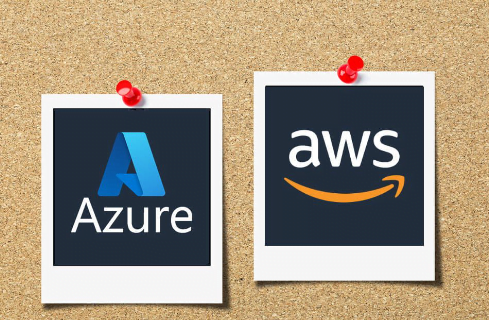DBT Bureau
Pune, 25 April
The picture of Amazon Web Services(AWS) Vs Microsoft Azure

Amazon Web Services (AWS) and Azure by Microsoft deliver cloud capabilities and similar set of core features but
each offering a wide range of services and serve to different needs. Both are well respected members of cloud computing market ,however they differ from each other in some essential aspects.
The approach to computing power provisioning and usage:
The primary issue with computing is scalability. AWS uses elastic cloud computing (EC2) in which the resource footprint available . It may increase or shrink on-demand as a result of elastic cloud computing resource provisioning. Local clusters provide just a piece of the resource pool which is accessible to all processes simultaneously.
EC2 users can create their virtual machines (VMs), pick machine images (MIs) which are pre-configured or modify MIs and they can modify ability, size and memory of the VMs as per their requirement. They can also choose the number of virtual machines they need.
On the other hand, Azure users are given the option of creating a VM from a virtual hard disc (VHD). It uses virtual scale sets to provide scalability and enable load balancing. The main distinction is that EC2 may be customized for various uses, whereas Azure VMs work in tandem with other cloud-deployment tools.
Data Privacy :
AWS performs a good job of selecting secure alternatives ,settings by default and ensuring enhanced privacy. Azure uses Microsoft’s Cloud Defender service for security and data privacy which is an AI (artificial intelligence) powered solution that protects against new and emerging threats. However, Azure services may not be 100% secure by default, such as virtual machine instances deployed with all ports open unless otherwise configured.
Networking and content delivery:
Finding a secure and isolated network is vital for cloud users, and network performance is a key parameter in cloud solutions. Both AWS and Azure have their perspective on the creation of isolated networks.
Users can use the cloud to generate isolated private networks using AWS’ virtual private cloud (VPC). Application programming interfaces (API) gateways are then used for cross-premises connectivity. During network connectivity, elastic load balancing is used to ensure smooth operation. Within a VPC, users have many possibilities for creating private IP ranges, route tables, network gateways, etc.
In comparison, Azure leverages a virtual network instead of a VPC. A virtual private network (VPN) gateway provides cross-network communication.
Cloud-compatible firewall alternatives are available from both AWS and Microsoft Azure to extend on-premise data centers into the cloud without endangering data or business processes.
Market Share: AWS is the first to market and has been the leader for a longtime where it holds a bigger share of the cloud market. It has a remarkable advantage in terms of market share. It currently holds the lion’s share of the cloud market, with a customer base that includes some of the biggest companies in the world. On the other hand, Azure has been steadily gaining ground and is the preferred choice for many businesses that already use Microsoft products.
Focus Area : AWS has traditionally focused more on providing infrastructure as a service (IaaS), offering a wide range of scalable computing resources such as virtual machines and storage, where as Microsoft Azure has a strong focus on platform as a service (PaaS), providing a comprehensive set of tools and services for application development, enhancement,deployment and management.
Pricing and Cost:
In terms of pricing, AWS and Azure both offer reasonable pricing and a pay-as-you-go pricing model. Moreover, both provide free introductory packages to give users allowing customers to pay only for the resources they are using. AWS is billed on an hourly basis, with instances purchasable:
On-demand: Pay only for the resources and services you use
Spot: Offer for extra capacity availability
Reserved: Reserve an instance for up to three years with an upfront payment
Meanwhile, Azure is billed on a per-minute basis, which means users can gain from a more exact pricing component than AWS. It also allows you to enter short-term commitments to choose from prepaid or monthly charges. Short-term subscription plans on Azure provide more flexibility. Furthermore, pricing for Microsoft Azure using BT MPLS ExpressRoute is available, allowing you to improve private corporate networks into the cloud with appropriate functionality.
However, In both comparision Azure usually turns out to be the more expensive option and can also add to a company’s cloud costs. This can be demonstrated in the example of Azure instances, which get more expensive as they grow in size. Azure will cost nearly twice as much as AWS for a 256GB RAM and 64vPCU configuration.
While both AWS and Azure are cloud computing powerhouses, they have their own unique strengths . AWS is known for its market dominance and extensive range of services, while Azure leverages its integration with Microsoft products. Ultimately, the choice between the two will depend on the specific needs and preferences of businesses. It’s always a good idea to evaluate both providers and their offerings before making a decision.





















